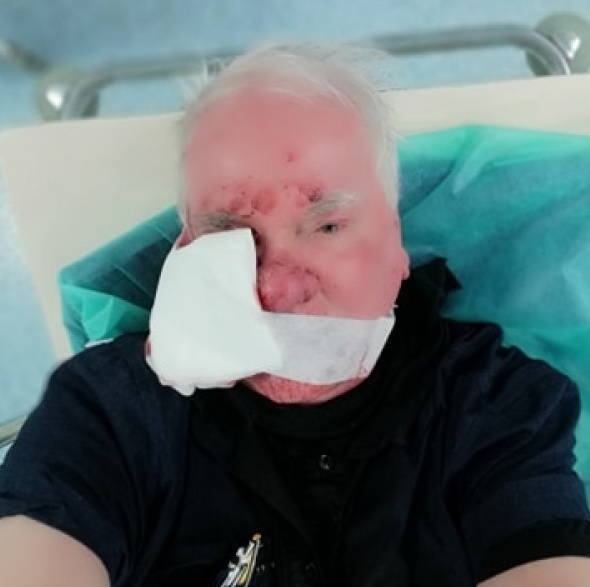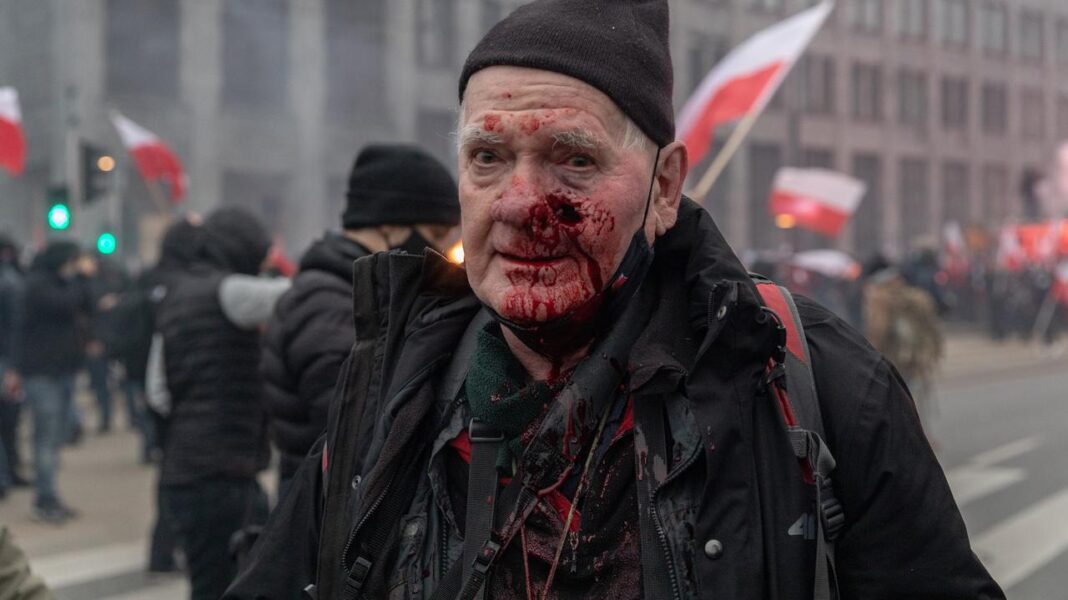The International Press Institute (IPI) today strongly condemned police violence against photojournalists reporting on clashes in the Polish capital Warsaw. The violence led to numerous injuries and the hospitalization of a 74-year-old photographer who was shot in the face with a rubber bullet.
IPI, a global network of editors, media executives and leading journalists for press freedom, said that in each of the attacks the journalists in question had either been wearing “PRESS” signs or were otherwise clearly identifiable as members of the media.
The incidents happened on November 11, 2020 as media covered violent clashes between police and members of far-right and nationalist groups during the annual Independence Day march through the capital.
IPI Deputy Director Scott Griffen said the acts of aggression towards the media were shocking and unacceptable and called on the commander of the Warsaw Police, Paweł Dobrodziej, to ensure a thorough investigation was carried out to identify those responsible.
“While we understand this was a volatile situation for police to handle, nothing excuses the unnecessary and at times brutal violence against photojournalists, all of whom wore PRESS insignia or who clearly and loudly identified themselves as media”, Griffen said. “This suggests that officers knew exactly what they were doing.”
“Such heavy-handed action seriously jeopardized the safety of journalists and led to the grave injury of a veteran photojournalist. We express our full solidarity and support with all those injured and strongly condemn the actions of those police officers responsible.”
He added: “The Warsaw Police Department must accept full responsibility. While we welcome the public apology form Mr. Dobrodzie, we urge both the head of the Ministry of Interior and Administration, Mariusz Kamiński, and the head of the Control Department of the Warsaw Police, Ilona Bednarczyk, to ensure that investigations identify those officers responsible for the clear breach of rules on the use of projectiles and direct coercion measures. Proper training of police units should also be carried out across the department to ensure such violence is not repeated.”
On Thursday, the Polish ombudsman for citizen rights released a statement saying police had used “physical violence” and “direct coercion” against journalists. The deputy commissioner for human rights, Stanisław Trociuk, also requested an explanation from the chief of police.
Journalists in the firing line
Among those injured were Tomasz Gutry, a 74-year-old long-time photojournalist for the Polish weekly magazine Tygodnik Solidarność, who was shot in the face with a rubber bullet by a police officer from a distance of several meters.
According to his employer, Gutry had been standing around 10 metres from a police officer and had been visibly holding a camera when the projectile was fired. It hit him in the cheek and needed surgery to be removed.

The majority of the injuries by media workers were sustained amidst heavy clashes near the Warszawa Stadion railway station in the east of the city. Video footage posted to social media shows police using their truncheons to hit journalists and photographers who had become pinned against a flight of stairs in the station by a crowd of officers preparing for an advance.
Among those beaten was Renata Kim, a journalist from weekly news magazine Newsweek Polska, who reported being hit in the kidney twice with a police baton even though she was wearing a bright vest with the inscription PRESS.
During the same incident, Przemysław Stefaniak of OKO.press was pepper sprayed and hit on the legs with a baton after he around five other photojournalists tried to flee. Stefaniak said police had pushed the group into the station with their riot shields, where they had been trapped against a wall the crowd of riot police officers.
“They had large, journalistic cameras and long lenses with them”, he told OKO.press. “I was wearing the PRESS armband and at one point I even took my ID card out of my pocket. We shouted loudly that we are from the press, we are photographers. There is no way they would not hear it.” The same footage appears to show one office throw a stun grenade at nearby journalists.
🇵🇱 Photojournalists from @NewsweekPolska, @gazeta_wyborcza & others were injured by police officers as they covered far-right protests in #Warsaw
Tomasz Gutry, 74, was hospitalised after being shot in the face with a rubber bullet from a close distance⬇️https://t.co/7AuQUa2Wgq pic.twitter.com/jxrv8Htgvm
— IPI – The Global Network for Press Freedom (@globalfreemedia) November 12, 2020
Another photojournalist for Newsweek Polska, Adam Tuchliński, and Dominik Łowicki, a reporter for leading daily Gazeta Wyborcza, were also reportedly hit on the back and legs with batons by police during the same incident. Gazeta Wyborcza reported that Łowicki was also pepper sprayed and that just before the police officer hit him, he had held up his hands and shouted “media”.
Dr. Jolanta Hajdasz, director of the Press Freedom Monitoring Center at the Polish Association of Journalists (SDP) in Poland called for investigations urged the authorities and public organizations to take steps to prevent any attacks on journalists and media workers performing their duties.
In a statement of apology issued on Friday, Paweł Dobrodziej, the commander of the Warsaw Police, said that police had tried to ensure the safety of the journalists present but added that during “dynamic activities” against hooligans, “it may happen that outsiders may also be injured.” He also apologized directly to Gutry for the injured he sustained and said he has issued a recommendation that the Control Department handle the matter.
It comes one week after Gazeta Wyborcza photojournalists Magda Kozioł and Joanna Urbańska-Jaworska were violently attacked by masked protesters as they documented the Women’s March in Warsaw.
This statement by IPI is part of the Media Freedom Rapid Response (MFRR), a Europe-wide mechanism which tracks, monitors and responds to violations of press and media freedom in EU Member States and Candidate Countries.

